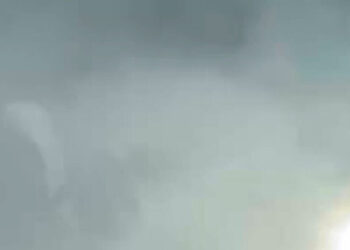President Donald Trump’s announcement this month that the United States would restart nuclear weapons testing on an “equal basis” with other nations — alluding to unverified claims that Moscow and Beijing are conducting secret tests and suggesting the U.S. will revive programs abandoned in the early 1990s — has sowed confusion among the world’s nuclear powers and revived echoes of the Cold War arms race.
While Moscow was quick to call for proposals on restarting its own nuclear weapons testing program, Beijing has stayed largely silent. But in the remote deserts of western China, the People’s Liberation Army has long been bracing for just this kind of threat.
In far western Xinjiang, satellite imagery and expert analysis show that China is rapidly expanding a historic nuclear test site, where it conducted its first atomic bomb test in 1964. The country’s military has quietly carved new tunnels, hollowed out explosive chambers and built support facilities that researchers say suggest preparations for nuclear testing.
Though China’s nuclear program remains years behind those of Russia and the United States, analysts say it is precisely that disparity that may be driving the apparent expansion of its testing facilities.
“Given the fact that China has conducted the smallest number of nuclear tests, it has much less empirical data. … China may have a need to conduct more experiments at either the subcritical level or through very low-yield supercritical testing to learn more about nuclear weapons,” said Tong Zhao, a senior fellow at the Carnegie Endowment for International Peace.
Behind China’s drive to expand its nuclear arsenal — currently the world’s third largest — is a broader strategy under President Xi Jinping to modernize the country’s military by 2030 and achieve a world‑class force by the middle of the century.
“China is increasingly interested in acquiring the capability to manage nuclear escalation at the regional level … [it] has an incentive to develop lower-yield warheads, and that need may be part of what China is doing in the testing side,” Zhao said.
In comments posted to Truth Social in late October, just minutes before his first in-person meeting with Xi since his second term, Trump warned that China would “be even” with the U.S. in nuclear warheads within five years — a claim analysts say is unlikely.
China’s arsenal, currently about 600 warheads and projected to reach roughly 1,000 by 2030, remains far below the estimate of 3,700 in the U.S. stockpile, according to independent analysis from the Stockholm International Peace Research Institute.
Testing of nuclear weapons was banned under the 1996 Comprehensive Nuclear-Test-Ban Treaty (CTBT), which prohibits nuclear explosions. The treaty has helped build broad international consensus on nonproliferation, but it has never been ratified by China or the United States — and Russia withdrew its ratification in 2023.
Under the treaty, a range of experiments are permitted, including computer simulations and subcritical testing — in which fissile materials such as plutonium or uranium are used without triggering an explosive nuclear chain reaction.
The U.S. State Department raised concerns in 2020 that China may be violating the treaty by conducting “low-yield” tests — small underground nuclear detonations in violation of the CTBT that are difficult to detect.
In a brief response to Trump’s comments that the U.S. will restart testing, China’s Foreign Ministry denied claims that it conducts nuclear testing outside of the CTBT standards. Spokeswoman Mao Ning said China “adheres to its nuclear testing moratorium” and “follows a policy of ‘no first use’ of nuclear weapons.”
China’s nuclear program is highly secretive, and insights into its development are limited, with only a handful of Western experts ever visiting its remote facilities. But at Lop Nur — the massive military site in Xinjiang where China conducted its first nuclear test and which has drawn comparisons to the U.S. Nevada Test Site — analysts who track regular developments say vast changes are underway, suggesting that China’s military is building infrastructure that could support larger or more frequent nuclear tests.
The site has undergone a surge of infrastructure development since 2020, including the excavation of two new large boreholes drilled deep into the desert, which analysts say are probably preparations for specialized vertical shafts designed for higher-yield nuclear detonations.
“Altogether, this represents a dramatic expansion of infrastructure and dramatic expansion of overall testing capability at Lop Nur in the last five years,” said Renny Babiarz, vice president at AllSource Analysis, who conducts regular geospatial analysis of the sites.
Drilling at those sites began in 2021, and activity has been steady through 2025, Babiarz found, including expansion of nearby support areas and electrical infrastructure, as well as regular heavy vehicle activity. The new construction is east of a historic vertical shaft where China conducted explosive nuclear tests before the 1996 treaty ban.
Also underway is new construction at a series of horizontal tunnels that could support smaller explosive nuclear tests at the northern rim of the Lop Nur complex, including the excavation of large amounts of earth from the tunnels, documented in January this year.
“Horizontal tunnels have historically been used for lower-yield nuclear weapons tests … up from a little over zero to 10 kilotons in size, while underground testing via vertical shaft has been for larger-yield nuclear weapons tests,” Barbiaz said.
Much of the development at the complex in the past two years has also been at a central command facility at the heart of Lop Nur, which has seen the construction of new buildings and an increase in traffic.
In its 2024 report on China’s military buildup, the Pentagon said Beijing’s “possible preparation to operate its Lop Nur nuclear test site year-round and lack of transparency on its nuclear testing activities have raised concerns about its adherence to the U.S. ‘zero-yield’ standard.”
The report also said China appears to be rapidly expanding its missile forces and nuclear materials program.
This month, following Trump’s comments that China and Russia are conducting secretive tests, CIA Director John Ratcliffe appeared to confirm that assessment in a post on X.
Barbiaz and other analysts caution that while the expanded footprint of China’s nuclear testing facilities is clear, it does not by itself indicate an increased intention to conduct a nuclear-first strike.
“At the operational level there is always this question whether the buildup will also lead to more Chinese interest in initiating nuclear employment in future conflicts. I think the answer is not necessarily,” Zhao said. He added that factors such as China’s growing capability in conventional warfare, especially in the Western Pacific, could reduce their dependency on nuclear deterrence as a national security priority.
Beijing has repeatedly stated — including in its 2019 national defense white paper — that it supports the eventual complete prohibition and “thorough destruction” of nuclear weapons and adheres to a no-first-use policy. The paper emphasizes that China “does not engage in any nuclear arms race with any other country and keeps its nuclear capabilities at the minimum level required for national security.”
While Beijing maintains it is committed to denuclearization, it has also repeatedly rejected overtures to join discussions with U.S. officials on the matter, and diplomatic channels on the topic have proved fragile.
In July last year, Beijing unilaterally suspended nonproliferation talks with the United States over ongoing U.S. arms sales to Taiwan. More recently in September, Beijing said it would not join denuclearization talks with the Washington and Moscow, with the Chinese Foreign Ministry saying their participation was “neither reasonable or realistic.”
“Publicly, their open perspective is: We still have a small arsenal; U.S. and Russia are in a different class; they need to come down to our level, and then we’re willing to talk,” said Pranay Vaddi, a senior nuclear fellow in the Center for Nuclear Security Policy at the Massachusetts Institute of Technology and the former senior director for arms control, disarmament and nonproliferation at the National Security Council during the Biden administration.
“I think that they also use opacity regarding their nuclear arsenal historically as sort of deterrent enhancing. If they know that being opaque and not talking about their nuclear weapons creates concerns or hesitations on the U.S. side, they think that’s good for China,” he said.
Graphics by Adrián Blanco Ramos.
The post China expands desert nuclear test site as Trump revives nuclear tension
appeared first on Washington Post.




